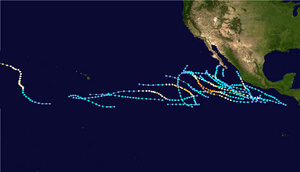1987 Pacific hurricane season facts for kids
 |
|
| Season summary map | |
| First storm formed | June 7, 1987 |
|---|---|
| Last storm dissipated | October 3, 1987 |
| Strongest storm | Max – 155 mph (250 km/h) Peke – 105 mph (165 km/h) |
| Total storms | 20 |
| Hurricanes | 10 |
| Major hurricanes (Cat. 3+) | 3 |
| Total fatalities | Unknown |
| Total damage | Unknown |
| Pacific hurricane seasons 1985, 1986, 1987, 1988, 1989 |
|
The 1987 Pacific hurricane season was a time when tropical storms and hurricanes formed in the eastern and central parts of the Pacific Ocean. This season officially started on May 15, 1987, for the eastern Pacific and June 1, 1987, for the central Pacific. It ended on November 30, 1987. These dates are chosen because most tropical cyclones usually happen during this period each year.
Even though twenty tropical cyclones formed this year, not many of them caused big problems. Only three storms came close to land. Hurricane Eugene was the first Pacific hurricane to hit Mexico in July since at least 1949. Tropical Storm Pilar and Hurricane Norma also got close to land. The leftover parts of Hurricanes Ramon and Norma brought rain to the Continental United States. Another storm, Hurricane Peke, was a strong hurricane in the central North Pacific. It crossed the International Date Line and became a typhoon.
Contents
What is a Pacific Hurricane Season?
A Pacific hurricane season is a period each year when tropical storms and hurricanes are most likely to form in the Pacific Ocean. These powerful storms get their energy from warm ocean waters. They can bring strong winds, heavy rain, and big waves.
How Storms Are Named
Tropical storms and hurricanes are given names to help people keep track of them. This makes it easier for weather experts and the public to talk about specific storms. The names are chosen from a list that repeats every few years.
Important Storms of 1987
Even though there were many storms, only a few were notable. Here's a look at some of the most important ones from 1987.
Hurricane Eugene
Hurricane Eugene was a significant storm because it was the first Pacific hurricane in a long time to make landfall in Mexico during July. When a hurricane makes "landfall," it means the center of the storm crosses over a coastline. This can bring very strong winds and heavy rain to the areas it hits.
Tropical Storm Pilar and Hurricane Norma
Tropical Storm Pilar and Hurricane Norma were two other storms that came close to land. Even if a storm doesn't make direct landfall, it can still cause problems. Strong winds, heavy rain, and large waves can affect coastal areas nearby.
Hurricanes Ramon and Norma's Remnants
After hurricanes weaken and break apart, their "remnants" (what's left of them) can still bring weather changes. The remnants of Hurricanes Ramon and Norma moved over the United States. They caused rain in parts of the country, even though the storms themselves were no longer strong hurricanes.
Hurricane Peke
Hurricane Peke was a powerful storm that started in the central North Pacific. It did something interesting: it crossed the International Date Line. When a storm crosses this line from east to west, it changes its name from a "hurricane" to a "typhoon." This is because different parts of the world use different terms for these types of storms.
Want to Learn More?
- Tropical cyclone: Learn more about these powerful spinning storms.
- List of Pacific hurricane seasons: See a list of all the Pacific hurricane seasons.

